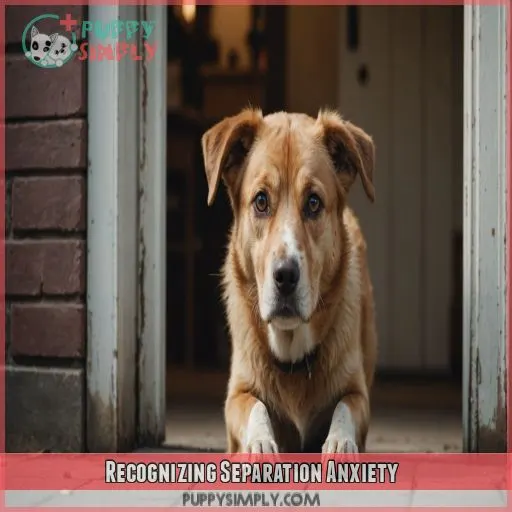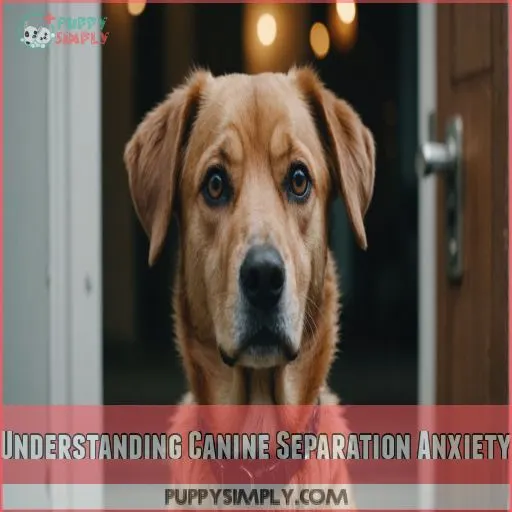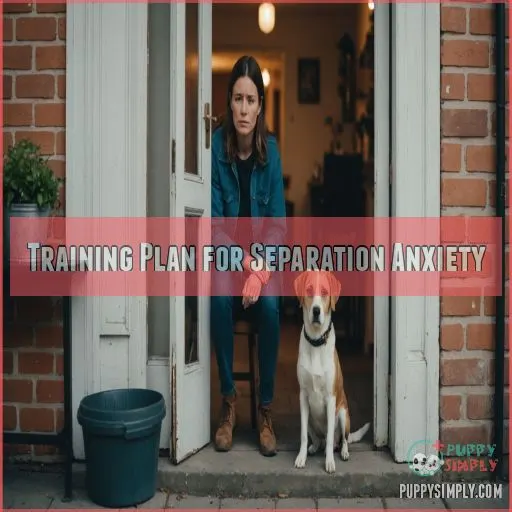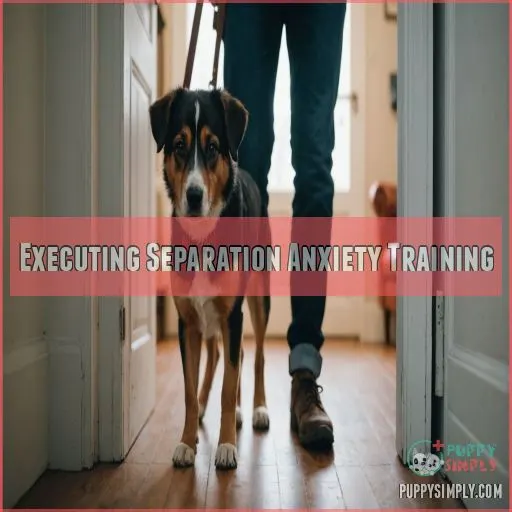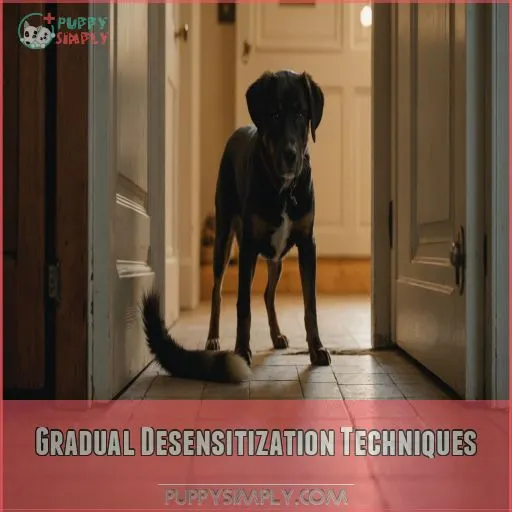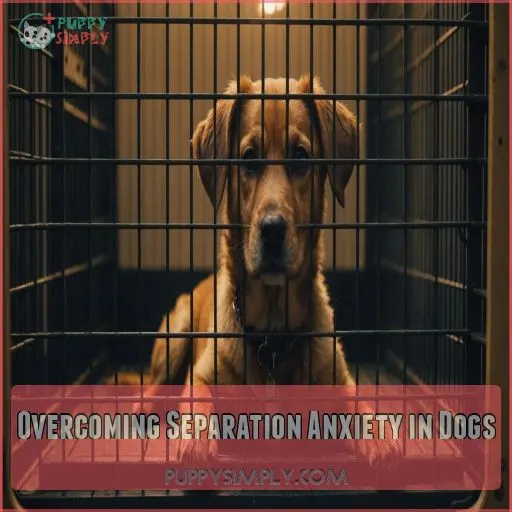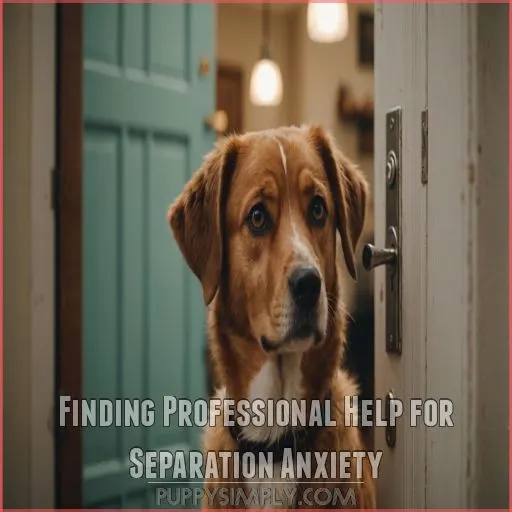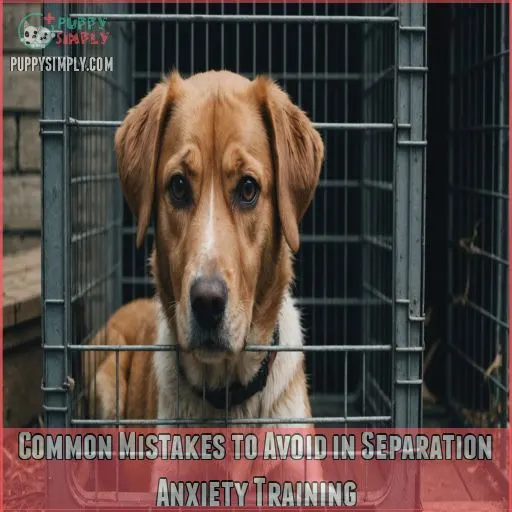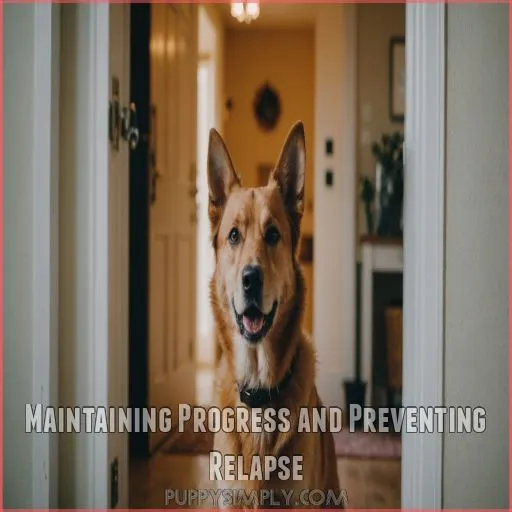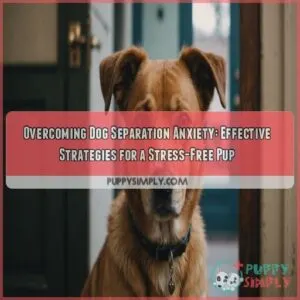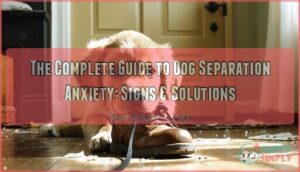This site is supported by our readers. We may earn a commission, at no cost to you, if you purchase through links.
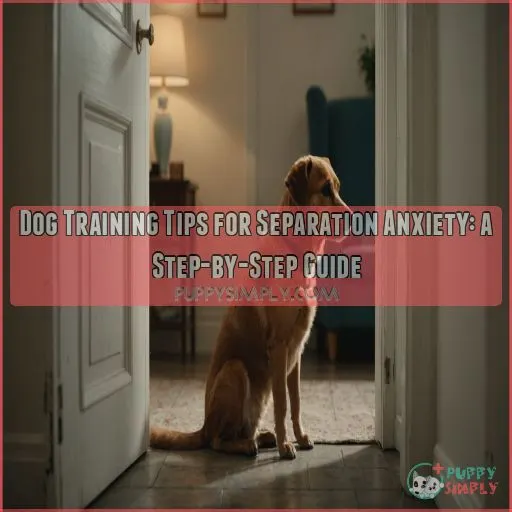 Helping your pup overcome separation anxiety isn’t just a walk in the park, but it’s manageable with the right dog training tips.
Helping your pup overcome separation anxiety isn’t just a walk in the park, but it’s manageable with the right dog training tips.
Start by recognizing those sneaky signs like excessive barking or chewing (we’re looking at you, couch!).
Gradually lengthen your time apart to teach your dog that you’ll always come back.
Turn leaving cues like grabbing keys into positive experiences—think of them as the popcorn before the main movie!
Be patient and know that a calm, confident dog leads to a calm, confident you.
Keep an eye on our upcoming tips for more paw-some strategies to help your furry friend!
Table Of Contents
- Key Takeaways
- Recognizing Separation Anxiety
- Understanding Canine Separation Anxiety
- Training Plan for Separation Anxiety
- Executing Separation Anxiety Training
- Managing Separation Anxiety in Dogs
- Gradual Desensitization Techniques
- Overcoming Separation Anxiety in Dogs
- Finding Professional Help for Separation Anxiety
- Common Mistakes to Avoid in Separation Anxiety Training
- Maintaining Progress and Preventing Relapse
- Frequently Asked Questions (FAQs)
- How to break a dog from separation anxiety?
- Can a dog be trained out of separation anxiety?
- What is the best treatment for dogs with separation anxiety?
- Is dog separation anxiety curable?
- How can I help my dog feel less anxious during my absence?
- What are some effective calming techniques to use before departures?
- How long does it typically take to resolve separation anxiety?
- Can medications be used to manage separation anxiety in dogs?
- What are the signs that my dogs anxiety is improving?
- Conclusion
Key Takeaways
- Recognize the Signs Early: It’s like being a detective! Spotting clues like excessive barking or destructive behavior can help. Knowing what to look for is half the battle—your couch (and neighbors) will thank you!
- Gradual Desensitization Is Your Friend: Think of it like teaching your pup to slowly ride the roller coaster of alone time. Start with quick trips out the door, and build up to longer breaks. Baby steps make a confident furball!
- Positive Reinforcement Is Key: reward calm behavior with treats and praise. It’s like you’re throwing a little party every time your dog stays relaxed. Remember, a happy pup learns best!
- Consistency and Patience Will Pay Off: Training isn’t a sprint, it’s more like a marathon. Stick to a routine and stay cool even when things get shaky. You’re crafting a masterpiece of calmness, one training session at a time!
Recognizing Separation Anxiety
Spotting separation anxiety in your dog can be as clear as an Oscar-worthy dramatic scene when you leave the house—complete with the barking, pacing, and an attempted jailbreak.
Understanding these signs and pinpointing their start is really important to help your furry friend stay calm and confident while you’re away.
Common Symptoms in Dogs
Spotting separation anxiety in your pup can be like finding a needle in a haystack!
Keep an eye out for these signs:
- Destructive behavior: Shoes or furniture getting a makeover?
- Excessive barking: Is it a concert or just your dog missing you?
- Pacing behavior: Is there a marathon in your living room?
- Hiding behavior: Does your dog vanish like Houdini?
Understanding these anxiety signals can help you tackle isolation distress effectively.
Identifying Thresholds for Separation
To pinpoint your pup’s separation threshold, try the stopwatch method.
As you leave, start a timer and observe their behavior – when do the pacing, whining, or other stress signals begin?
This tells you their limit before anxiety sets in.
Jot down the time to guide your gradual desensitization training.
Every dog is different, so be patient and adjust as needed.
Distinguishing Separation Anxiety From Other Issues
Unraveling whether your dog’s behavior stems from separation anxiety or another issue doesn’t have to feel like chasing your tail understanding English bulldog behaviors! Consider these clues:
- Dog boredom might lead to destruction if left alone.
- Medical issues can cause accidents indoors.
- Attention seeking often accompanies curtain-chewing.
- Fear of noise causes panic at loud sounds.
Consult a certified separation anxiety trainer for clarity.
Impact of Separation Anxiety on Dog Behavior
Does Fido chew up your favorite shoes or pace like a marathon runner when you’re out? These signs of separation anxiety, like destructive behavior or urinary problems, can make any dog parent anxious.
Unchecked, anxiety triggers can lead to social withdrawal or even aggression issues.
With a solid training plan and positive reinforcement, you can ease your dog’s stress.
Understanding Canine Separation Anxiety
Understanding canine separation anxiety is like deciphering the secret life of your dog; it’s often rooted in their attachment to you and can be influenced by past experiences.
By grasping the factors that contribute to their anxiety, like changes in routine or even your own behavior, you’ll be better prepared to help your furry friend feel secure and relaxed when you’re not around.
Causes of Separation Anxiety in Dogs
The causes of separation anxiety in dogs can be complex, but understanding them is key to providing the right support.
Some common factors include:
- Lack of early socialization
- Past traumatic experiences
- Breed predispositions
- Overly attached owner-dog relationships
By addressing these underlying causes, you can help your furry friend overcome their separation woes and enjoy a more confident, independent life.
Role of Owner Interaction in Separation Anxiety
Although your dog treasures your companionship, fostering independence is key.
Your relationship, or owner-dog bond, shapes their attachment style.
If you act like their sole safety net, they’re more prone to panic when you’re gone.
Gently introduce separation triggers, like picking up keys, using positive reinforcement and training consistency to create a calm, confident pup.
Remember, practice makes paw-fect!
Factors Contributing to Separation Anxiety Development
Owner interaction plays a massive role, but let’s face it—dogs aren’t fully built from cuddles alone. Early socialization (or lack thereof), breed predispositions, and environmental changes shape their anxious disposition. Here’s the scoop:
- Early Socialization: Puppies need positive experiences.
- Breed Predispositions: Some breeds are naturally clingy.
- Past Trauma: Scary experiences linger like bad smells.
Training Plan for Separation Anxiety
Developing a training plan for your dog’s separation anxiety is much like creating a blueprint for success—you just have to stick to the plan, even on the tough days.
Let’s tackle this step by step, and before you know it, your dog will be cool, calm, and collected even while you binge-watch your favorite shows from another room!
Creating a Baseline for Your Dog
Alright, let’s get started on creating a baseline for your dog’s separation anxiety training. First, observe your pup’s behavior when you leave – note the first signs of stress and how long it takes for those behaviors to start. This will give you a clear starting point to build your training plan around. Ready to get started?
| Observation | Duration | Notes |
|---|---|---|
| Pacing | 2 minutes | Began as soon as I left the room |
| Whining | 5 minutes | Increased in intensity over time |
| Destructive Chewing | 10 minutes | Focused on windowsill and door frame |
Setting Goals and Objectives for Training
When setting goals for your dog’s separation anxiety training, it’s important to establish realistic and specific objectives.
Keep in mind that consistency is your friend, and measurable progress is key.
Think of it like building a house of patience brick by brick; each session aligns with your dog’s individual needs.
Remember, you’re in it for the long haul, and that’s okay!
Developing a Training Schedule and Routine
Creating a training schedule for separation anxiety is like baking a cake—patience is key! Consistency is your secret ingredient. Stick to a routine and watch your furry friend’s progress rise. Here’s how:
- Frequency: Train daily to build confidence.
- Duration: Start short, gradually increasing.
- Goals: Track improvements, celebrating small victories.
Strategies for Desensitizing Departure Cues
Your dog’s keen instincts can be overwhelming, but no need to jump ship! Start with gradual cue introduction to ease tension. Pair keys, shoes, and jackets with positive associations like treats. Consistency is key, friends; keep at it! Each dog dances to their own drum, so personalize your approach. Remember, Rome wasn’t built in a day!
| Strategy | Benefits |
|---|---|
| Gradual Cue Introduction | Reduces sudden anxiety spikes |
| Cue Pairing | Builds positive associations |
| Positive Association | Encourages calm responses |
| Consistency is Key | Reinforces learning and security |
Executing Separation Anxiety Training
Executing separation anxiety training requires careful preparation and a positive approach, just like crate training a Beagle.
By creating the right environment and using effective techniques, you can help your pup overcome their fears and build confidence.
Preparing the Training Environment
Before kicking off the training, take a hard look at your environment.
Craft a safe, quiet space where your furry pal feels right at home.
Perhaps a cozy corner adorned with familiar objects will do the trick.
Remember, distractions are your nemesis here.
You wouldn’t try meditating in a rock concert, would you?
So, set the stage right!
Using Positive Reinforcement Techniques
When tackling separation anxiety, reward-based training is often your best friend.
Think clicker training; it’s like teaching your pooch to play connect-the-dots with good behavior!
Each ‘click’ signals a job well done, followed by a treat.
Positive reinforcement is key—like giving high-fives with treats!
Remember, patience is a virtue and persistence shapes behavior.
Your dog’s confidence will blossom!
Managing External Distractions and Interruptions
Imagine you’re the conductor guiding an orchestra of calm.
Noise reduction is your baton.
Keep a consistent training schedule while blending household routines with unexpected symphonies.
Manage visitors like surprise notes—welcome, not overwhelming.
Embrace routine changes with finesse, making them smooth shifts.
Your dog will learn to dance to this steady beat, calm and secure in the melody of your guidance.
Recognizing Stress Signals in Dogs
Pay close attention to your dog’s body language during training.
Look for subtle signs like panting, lip licking, pacing, or tail tucking – these could indicate rising stress levels.
Adjust your approach immediately if you notice these stress signals, taking a break or ending the session to avoid overwhelming your pup.
Stay tuned in to their needs, and you’ll make steady progress.
Managing Separation Anxiety in Dogs
Managing your dog’s separation anxiety isn’t just about keeping them calm; it’s also about keeping you from stressing out!
With a little training magic and a sprinkle of patience, you can help your furry friend feel secure while giving yourself peace of mind.
Preventing Escalation of Anxiety
Picture your dog in a safe space, like their cozy bed, while you calmly establish consistent routines like creating a calming environment. Use positive reinforcement when they signal calming behaviors.
Spot anxiety triggers early—think of them as storm clouds on the horizon. Redirect focus with simple commands, easing tension.
You’ll build a foundation as solid as a wagging friendship, preventing anxiety escalation.
Utilizing Tools and Aids for Training
To manage your dog’s anxiety effectively, using tools and aids can work wonders.
Food puzzle toys, like KONGs filled with yummy treats, keep them busy, while desensitizing gates or crates offer safe spots.
Think of these as secret weapons in your training toolkit.
Keep it fun, and you’ll find your furry friend happier and calmer in no time!
Creating a Support System for Your Dog
Enlist a support team to help your dog overcome separation anxiety. Hire a dog walker or pet sitter to provide companionship when you’re away.
Involve family members in training sessions to make sure consistency.
Consider group training classes to socialize your pup and learn from other owners facing similar challenges. Online forums can also connect you with a community of understanding pet parents.
Managing Owner Anxiety and Emotional Response
Managing your own anxiety is really important when dealing with your dog’s separation anxiety.
- Breathe and practice mindfulness techniques.
- Join support groups to share experiences.
- Remember your emotional impact at home transfers to your dog.
- Laugh at setbacks and successes alike—because humor’s a great stress reliever! Keep your chin up, and give these coping strategies a go!
Gradual Desensitization Techniques
Gradual desensitization is like teaching your dog to watch you leave without turning it into a drama—we’re talking short exits and tiny steps here!
You’ll add to your dog’s confidence while sneaking outside, eventually making "goodbyes" just another part of the day, like when you remember to grab your keys but forget where you parked.
Implementing Gradual Desensitization Training
Consider gradually desensitizing your dog’s anxiety by starting small. Leave for just a moment and build up! Make it a game, like hide-and-seek—your pup’s anxiety can’t play along! Stay consistent, and practice patience.
| Step | Activity | Duration (minutes) |
|---|---|---|
| 1 | Step outside door | 1 |
| 2 | Walk around block | 3 |
| 3 | Run quick errand | 5 |
| 4 | Brief coffee break | 7 |
| 5 | Chat with neighbor | 10 |
Increasing Duration of Absences
Gradually increase the duration of your absences to desensitize your dog to separation. Start with brief departures, like stepping out for a minute, and slowly work your way up. Pay close attention to your dog’s anxiety triggers and adjust the pace accordingly.
Consistency is key – stick to a regular training schedule for the best results.
- Begin with short, random departures to build positive associations.
- Incrementally increase the duration of your absences over time.
- Closely monitor your dog’s stress signals and adjust the training as needed.
Counterconditioning and Desensitization of Cues
Ever notice how your dog panics when you grab your keys? Pre-departure cues like these are anxiety triggers.
Use gradual exposure and positive reinforcement to ease your dog’s mind.
Step-by-step, mix it up—put on your shoes without leaving.
Over time, your dog will learn shoes don’t always mean you’re gone.
Consistency in training helps build their confidence!
Monitoring Progress and Adjusting Training
When tracking progress, imagine you’re a detective on a tail. Keep your notebook handy and jot down:
- Time your dog stays calm alone.
- Adjust goals based on behavior shifts.
- Spot patterns or triggers like a doggy Sherlock.
- Consistency matters—keep that flow steady.
You’ll laugh later, remembering the detective role you played!
Overcoming Separation Anxiety in Dogs
Tackling your dog’s separation anxiety might feel like a challenging puzzle, but don’t worry, you’ve got this! By focusing on strategies to reduce anxiety and build your pup’s confidence, you’ll develop a long-term training plan that can handle setbacks with ease.
Strategies for Reducing Anxiety
Helping your pup feel at ease starts with creating a calming oasis.
Set up a cozy, distraction-free spot with their favorite toys and treats.
Try relaxation techniques like pheromone diffusers or calming music to soothe their nerves for calming techniques.
When you leave, avoid big goodbyes – a simple, quiet exit can work wonders.
With patience and consistency, you’ll see those anxious behaviors melt away.
Building Confidence in Your Dog
Confidence building in your furry friend is key to trimming down their separation anxiety.
Use positive reinforcement when they show calm behavior.
Understand dog body language to know when they need a breather.
Create a safe space where they feel secure, much like their personal sanctuary.
Socialization helps too—just like us, dogs love company and new experiences!
Developing a Long-Term Training Plan
To develop a solid long-term training plan, keep your eyes on the prize and remember: slow and steady wins the race! Emphasize training consistency and goal setting by:
- Tracking progress reliably over time
- Adjusting training duration flexibly to suit your dog
- Maintaining schedule flexibility for real-life surprises
You’ll find these strategies put the pep back in your pup’s step!
Managing Relapse and Setbacks
When working on a long-term training plan, hiccups are inevitable. Don’t lose heart! It’s like a roller coaster—ups, downs, and loop-de-loops.
Focus on consistency and identify stress triggers.
Stepping back for training breaks might be needed.
Combat owner anxiety by leaning on your support system.
You and your pooch are in this together, pawsitive outcomes await.
Finding Professional Help for Separation Anxiety
While separation anxiety can be a challenging issue, you don’t have to go it alone.
Seeking the guidance of a certified separation anxiety trainer (CSAT) can make all the difference in helping your pup overcome their fears and anxieties.
Locating Certified Separation Anxiety Trainers (CSAT)
To effectively tackle separation anxiety, seeking help from a Certified Separation Anxiety Trainer (CSAT) can be a game-changer.
Discover trainers through CSAT directories or local networks, checking out their qualifications.
Online resources also help pinpoint options: think Yelp but for dog pros!
Remember—a good trainer will ease your anxiety too.
Anticipate training costs as part of your planning.
Working With a Professional Trainer
You’ve located certified separation anxiety trainers, but working with one is when the real magic happens.
Find a trainer whose approach and qualifications match your dog’s needs and your budget.
Communicate openly about your goals and expectations.
Professional trainers can adjust methods as needed, ensuring both you and your furry friend are on the same page, wagging tails and all.
Benefits of Professional Guidance
Teaming up with a pro can supercharge your dog’s training! Here’s why it pays to get expert guidance:
- Expertise brings insights you might miss.
- Tailored Plan gives your dog a customized approach.
- Personalized Support offers targeted help when you need it.
- Faster Results mean your pooch feels happier, quicker.
Embrace these benefits for a more serene pup.
Evaluating the Effectiveness of Training
When evaluating the effectiveness of your dog’s separation anxiety training, track their progress carefully.
Observe behavior changes, note the consistency of their calm responses, and get honest feedback from yourself and others in the household.
This long-term view will reveal the true impact of your efforts, so you can fine-tune the approach as needed.
Stick with it – your pup’s wellbeing is worth it!
Common Mistakes to Avoid in Separation Anxiety Training
When working on separation anxiety training with your dog, it’s easy to fall into some common traps that can hinder progress.
Don’t be that owner who expects instant results; remember, Rome wasn’t built in a day, and neither is a confident, calm dog!
Avoiding Punishment and Negative Reinforcement
Teaming up with a professional, remember that punishment isn’t the answer for your dog’s separation anxiety. Dogs don’t understand why they’re being punished, making them more anxious.
Instead, try positive reinforcement—reward calm behavior.
Consistency’s key! Think of training like building trust with a shy friend—patience and kindness will pay off much more than scolding ever could.
Preventing Over-Attachment and Separation Anxiety
To prevent over-attachment and ease separation anxiety, encourage your dog’s independence. Early socialization and crate training work wonders. Independent play boosts confidence, and positive reinforcement for calm behavior does wonders. Here’s the big cheese:
- Practice gradual separation.
- Don’t smother with attention.
- Reward calm independence.
- Introduce new activities.
- Schedule solo playtime.
You’ve got this. Keep calm and Wag on!
Minimizing External Stressors and Triggers
Minimizing external stressors and triggers is really important when training a dog with separation anxiety.
Avoid noisy environments, constant distractions, and disruptions to your dog’s routine.
Maintain a calm, consistent environment to help your pup feel secure.
With patience and attention to detail, you can create a peaceful space for successful training.
Managing Owner Expectations and Frustration
While reducing stressors, remember—Rome wasn’t built in a day! Set realistic goals and stay patient.
Consistency is your best friend; setbacks? They’re part of the process.
Like teaching a toddler to tie shoes, it takes time! Build a support system to manage frustration, and remember, a cheerleader squad for your dog isn’t hyperbole, it’s helpful!
Maintaining Progress and Preventing Relapse
Maintaining progress in training your dog to manage separation anxiety can feel like trying to keep a soufflé from collapsing, but it’s entirely doable with a plan and some expert tips.
To prevent setbacks, keep a consistent schedule, adjust strategies as needed, and remember that patience is your best friend in this journey.
Preventing Relapse and Setbacks
Change is inevitable, but keeping your dog’s progress solid is within your hands. Consistency is key! Watch for any pesky triggers that might sneak up, like unannounced guests or new environments.
Socialization can help reduce stressors, turning tense moments into joyful adventures.
Address these smoothly to dodge setbacks, keeping your fur-buddy’s paw on the path to relaxation.
Maintaining a Long-Term Training Schedule
Maintaining a consistent training schedule is key to preventing relapse. Stick to a routine, even on busy days – your dog will appreciate the predictability. Remember, progress takes time, so celebrate small wins along the way.
3 tips for staying on track:
- Set reminders for training sessions.
- Involve the whole family in the process.
- Reward your pup’s efforts with praise and treats.
Continuously Evaluating and Refining Training Strategies
Evaluating your dog’s progress is like checking the GPS on a road trip—essential for keeping on track!
Take notes after each session, and don’t shy away from tweaking the route based on your dog’s individual needs.
Keep an eye out for setbacks and prevent them by reinforcing successes.
Remember, patience is a virtue, and this journey needs it.
Frequently Asked Questions (FAQs)
How to break a dog from separation anxiety?
Crack the separation anxiety nut by identifying your dog’s stress threshold and gradually desensitizing them.
Start with short, random departures and gradually lengthen them.
Rocksteady patience and consistency are your best pals throughout this journey!
Can a dog be trained out of separation anxiety?
Imagine your dog like a kid learning to ride a bike.
Yes, you can train them out of separation anxiety!
With patience and gradual desensitization, they’ll gain confidence and soon handle alone time like a pro.
What is the best treatment for dogs with separation anxiety?
Training Fido out of separation anxiety takes patience, consistency, and a game plan.
Gradually desensitizing, counterconditioning with tasty treats, and calming exercises can work wonders.
Enlist professional help if needed, and remember—Fido’s not being dramatic, just anxious!
Is dog separation anxiety curable?
Separation anxiety in dogs is like a stubborn weed – with the right care and patience, you can nip it in the bud.
While not a quick fix, overcoming this challenge is absolutely within your reach.
How can I help my dog feel less anxious during my absence?
Start by gradually increasing the time you spend away, ensuring your dog’s never alone past their comfort threshold.
Use stuffed KONGs as a tasty distraction.
Consistency’s key—train regularly to build your pup’s confidence in your absence.
What are some effective calming techniques to use before departures?
Imagine you’re setting the stage for a peaceful symphony.
This can be your secret weapon against pre-departure jitters!
Spend a few moments with your dog, using calming activities like gentle petting or playing soft music.
How long does it typically take to resolve separation anxiety?
Resolving your dog’s separation anxiety can take weeks or months, depending on their temperament.
Patience and consistency are keys—it’s more of a marathon than a sprint.
Keep your chin up, and celebrate the small victories!
Can medications be used to manage separation anxiety in dogs?
Certainly, pup parents! Prescribed panacea can potentially pacify pooches plagued by pesky separation stress.
Consult your canine’s caring vet to craft a customized care plan – a pawsitive path to pup peace of mind.
What are the signs that my dogs anxiety is improving?
You’ll notice your dog is improving when they’re calmer during your departures, with reduced pacing or barking.
Their ‘meltdown moments’ will shorten, and they’ll seem more at ease during training—pat yourself on the back; you’re nailing it!
Conclusion
Think of tackling separation anxiety as solving a puzzle, where each piece represents different dog training tips.
By methodically identifying signs and understanding your pup’s needs, you’re building a caring bridge over their worries.
Step-by-step, you’ll transform those difficult moments into opportunities for growth.
Your confident, happy dog won’t just embrace your comings and goings—they’ll thrive on them!
Remember, every small success deserves a treat, so relish the journey of nurturing your furry friend!

